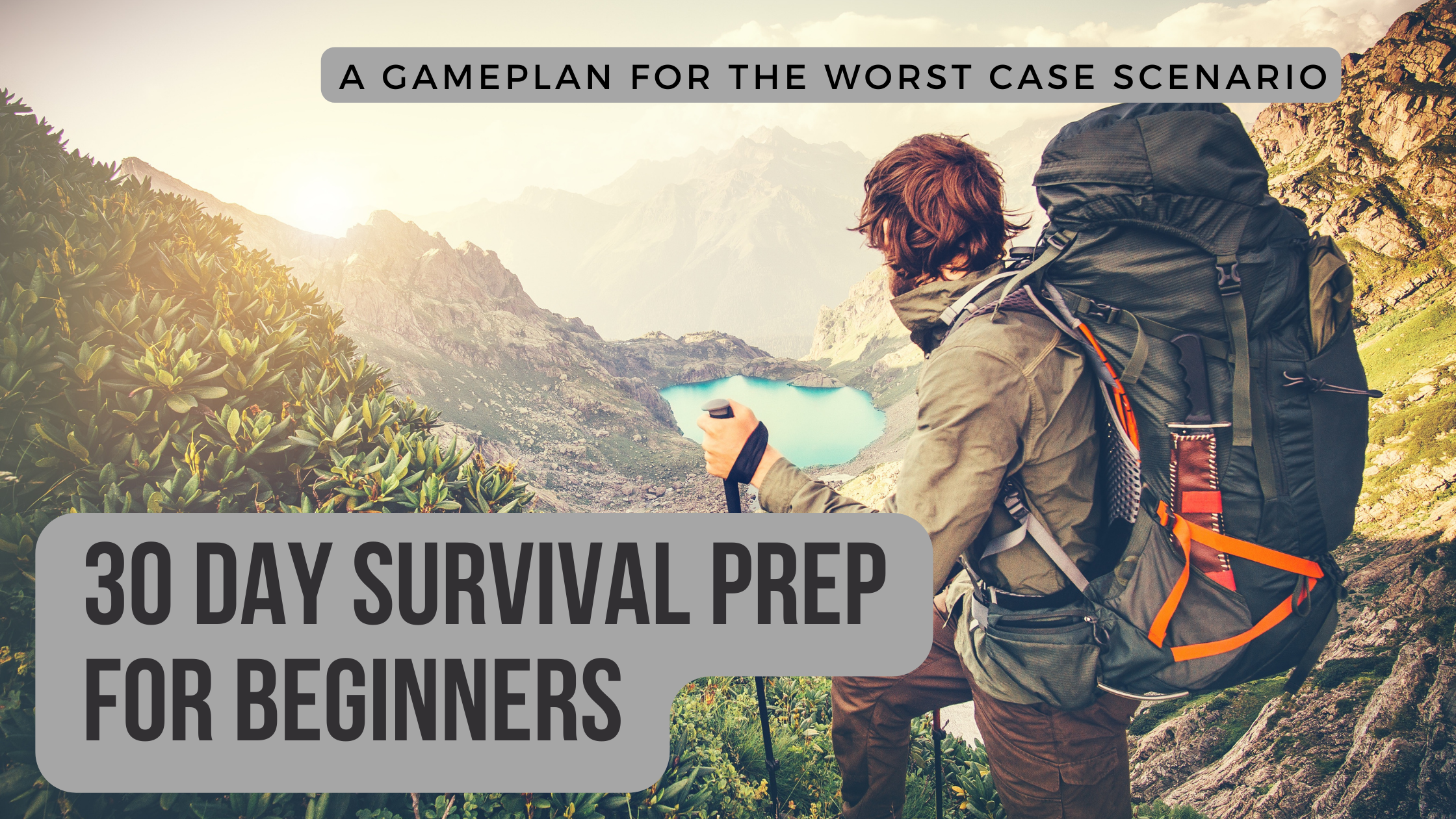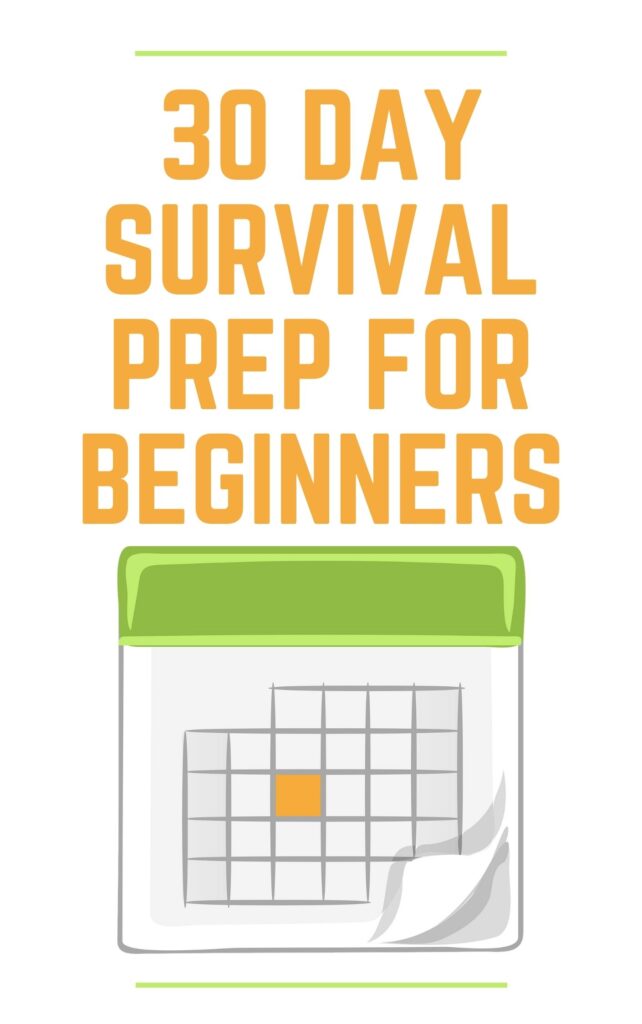Are you prepared for a worst-case scenario? If not, you need this 30 day survival prep for beginners guide!
30 Day Guide to Survival Prep
When preparing for a survival situation, there are many things you will need to make sure you do to be fully prepared for the worst scenarios possible. These things range from food and water stock, shelter, self-defense, and more.
Making sure that you have all the supplies needed to keep your family safe may seem overwhelming, but if you follow this thirty day plan you can be at ease knowing you and your family will be prepared for anything.
Day 1: Take Stock of the Supplies You Already Have
When you’ve made the decision to prepare for the survival of yourself and your loved ones, you have to know where you stand before you can make a plan to go forward. That means, you will need to take stock of all of the supplies you already own, whether or not you meant for them to be used for survival purposes.
You want to go through your entire house, savings, and skills to see what you are starting out with on hand. For example, for your water needs, you will see how many bottles of water or gallons of water you already have to supply your family with.
Next, you will go through your pantry to see what canned goods and dry goods you have on hand that will provide food for your family in a survival event. You also want to check things like first aid supplies, self-defense gear, and more.
Add the item that you have, the date that it expires, if applicable, and how many of that item you have on hand to your supply list. You will need to use the date later when you begin to rotate your food stores to keep everyone healthy.
Day 2: Calculate Your Water and Food Needs
When preparing your survival supply, it’s crucial to know how much food and water you’ll need to keep on hand for yourself and your family. Each person in your family should have a gallon of water to use per day.
This includes half of a gallon to drink, and the other half to use for other necessities like washing yourself and your clothes, cooking, etc. For calculating food needs, you need to take into account the height, weight, age, and gender of each family member.
There are many calorie calculators online that you can put information into and they’ll tell you how many calories each person will need per day. Write this information down so that you can gradually purchase water gallons and foods that help reach the caloric intake requirements of yourself and all of your family members.
Day 3: Begin Stocking Up On Brand Water
Water is one of the most important aspects of survival. It’s vital in maintaining a healthy family in a survival situation. This is why it is crucial to start stocking up on water early in your prepping journey.
When you go to the store, add some extra water gallons or water bottle packs to your shopping cart. This way you can gradually build up your supply without needing to buy out the entire stock of water at once.
Water bottles are a great thing to have in your survival stock because they are easier to carry around than a huge gallon jug. They can also be useful tools in filtering water you find outdoors.
Day 4: Invest in a Solution for Events with No Running Water
Sometimes during a survival situation like a hurricane, a power outage, or a snowstorm you may lose access to running water. This means you’ll be without a functioning sink, toilet, bath, hose, etc.
Losing access to running water can be scary if you’re unprepared – especially if the events are indefinite. However, there are ways to prevent this panic and unpreparedness from happening.
One great item you should buy to prepare for a water outage is a water bladder for your bathtub. These are just plastic storage bags that you set in your bathtub and fill up through the faucet.
Use a water bladder to prepare if you know a water outage could be coming. For example, if a hurricane is coming towards your home, fill it up prior to the hurricane’s arrival in case your power and water gets shut off.
If you don’t have time to prepare for a water outage, you’ll have to rely on the supply that you already have. This is why it’s important to make sure you stay stocked up on multiple gallons of clean, pure drinking water.
You should also get a rain barrel to store rainwater in. This will give you another source of water if there is nothing else available, but it may not always be safe to drink right out of the container. Make sure to purify it before drinking.
Day 5: Prepare for Stagnant Water Usage
There may come a time where you and your family will need to bug out and find drinking water from another source such as a lake, river, or pond. You’ll need to make sure you have the materials you need to be able purify this water so that you can use it safely.
You may want to purchase some straw filters for everyone in your family. These are just normal straws that filter out harmful particles and bacteria to make any stagnant water safe to drink.
You can also get some water purification tablets. All you need to do with these is drop it into a container of water and it will kill microorganisms that could harm your family. These tablets have set amounts of water that they are to be used in. Make sure you follow the instructions so that your water is fully disinfected.
Day 6: Clear Space for Survival Supplies
Designating a specific area of your home to your survival supplies is an extremely important step in your preparation. The state of the area that you store your items in can determine how long your supplies end up lasting.
You need to make sure you’re storing your supply in a place that is clean, dry, and cool so that no rodents or insects will get into your stuff. The last thing you would want in a survival situation is to find out your food has been infested by bugs.
Day 7: Start a List for Tracking and Rotating Food Supplies
Keeping track of the food you have will help you make sure that you always have enough on hand to feed your family when needed. It’s also important to know when you need to get rid of expired items so you don’t feed your family potentially harmful food.
Write down all of the food supplies you have along with the quantity that you have. If you happen to use something from your survival stock or add something to it, make sure you update the list accordingly.
You will also need to replace certain food items once they expire, so make sure you also have the expiration date written down to know when you’ll need to rotate it out for newer supplies instead.
Day 8: Create a List of Items to Add on to Your Weekly Shopping
Most people don’t have the room or the budget to buy up a whole bunch of food and survival items at once. Instead of doing that, you can gradually build up your stock by adding things you’ll put in storage to your weekly grocery shopping list.
Add things like bags of dry beans, bags of rice, peanut butter, yeast, canned foods, flour, etc. These things are cheap and typically last a long time, so you won’t have to constantly buy new supplies.
You should also look at deals and sales that are going on at your local grocery stores. Often, there will be “buy one, get one free” deals or “buy two for a lower price” deals that will help you build up your stock while saving money.
Coupons will also be helpful when building up your survival supply. You can usually find coupons in newspapers or in grocery store ads. You can even find them online or on couponing apps.
Day 9: Stock Up on Pantry Staples
Having basic pantry staples will be a crucial aspect in building up your food storage for survival situations. Without the necessities, your ability to cook basic foods will suffer greatly.
You should make sure you keep a plentiful stock of things like sugar, salt, and flour for any baking or cooking needs. Rice, beans, and spices are also important staples to make sure you keep stocked.
Having these foods in your supply will give you a wider variety of things you could make in a survival situation, where other resources like restaurants or grocery stores may not be available.
Day 10: Purchase Some Foods with a Long Shelf Life
There are many options on the market for foods with an extremely long shelf life. These items will be a great addition to your survival preparation because you can keep them in storage for years without having to replace them.
One great example of this is 25 year buckets of food. These items are usually freeze dried food that are prepared by adding water to them, making them an easy and accessible way to prepare meals in a dire situation.
Another food option with a long shelf life is MREs (meals ready to eat). MREs are pre-packed meals used by military personnel that are designed to be nutritious and provide the appropriate caloric intake for those in a survival situation.
Other foods with long shelf lives include white rice, dried beans, and honey. You can pick up these items at any grocery store and place them in your survival stock for as long as you need to, because these items don’t expire.
Day 11: Make a Garden Plan and Purchase Seeds and Supplies
Having a flourishing garden full of nutritious crops during a survival situation with food scarcity will be one of the most valuable things to your entire preparation and survival journey.
To make your garden plan, you’ll have to take into account where you live, because the climate and soil will differ from place to place. Research the best crops to grow in the area you live in, and what time of year you should be planting them.
Next, you’ll need to buy the seeds of the foods you decided to grow. You should also stock up on basic gardening supplies such as gloves, fertilizer, a trowel, a watering can, a rake, etc.
Day 12: Learn How and Begin to Can Your Own Foods
Canned foods typically last much longer than normal foods do, making them a better option for survival food than typical uncanned fruits and vegetables. Being able to can your own food will be a valuable skill to have when in a survival situation.
However, it is important to make sure you do this correctly and follow steps of research-backed canning methods. If you don’t, there is potential risk of creating unsafe food that may make you and your family sick if ingested.
There are many methods out there, but the most common ways to can food are the pressure canning and water bath methods. You can find videos and books on how to correctly can food using these methods or other ones that may work better for you.
Day 13: Plant Your Garden and Create a Schedule for Harvest
Today you will begin your garden by planting the seeds and using the supplies that you have already bought. Make sure you plant your crops in areas that work according to them specifically.
For example, some crops such as artichoke and kale prefer to not be in full sunlight all the time. You need to be fully educated on how to properly take care of your plants before you start growing them so that you aren’t wasting time or supplies.
Next, you’ll create a schedule for harvesting your crops. All you need to do for this is write down when you’ll need to gather the plants you’ve grown. Again, you’ll need to make sure you plan to harvest according to each individual crop and their specific needs.
Day 14: Purchase a Bug Out Bag and Fill It
A bug out bag is a portable carrier that stores necessities for a bug out situation. Usually, these bags are packed with 72 hours’ worth of supplies that you would need to be able to survive alone.
Any basic survival backpack should work just fine for a bug out bag. You can find these types of backpacks at sports stores, department stores, outdoor gear stores, and online shopping sites.
For the supplies, you should add basic survival needs that would help get you through being in a survival situation where you wouldn’t have access to your home or any of your storage.
The first things you should add are food and water. Make sure to add nutritious food that will keep you healthy and energized throughout the day. A few examples of foods you could add are dried fruit, nuts, canned fruits and vegetables, and granola bars.
As for water, you should prepare your bag with one gallon of water. You can use easily portable things such as water bottles, a water bladder, or a canteen to carry your water with you. Make sure to also add water filtration devices for additional days, since you won’t be able to carry a lot of water.
You’ll also need first aid supplies. Add a first aid kit to your bag and make sure you go over what’s in it in case you want to add anything else like extra bandages, medications you may need, etc.
Make sure to also pack for shelter. Many people use tarps to make their own shelters, but some use tents. You should also bring something for warmth like a durable, warm sleeping bag if space allows or you’re able to attach it with MOLLEs.
Another good source of warmth will be fires. In your bug out bag, you should pack things like lighters, matches, or magnesium fire starters. Being able to light fires will keep you warm and also help you purify water if needed.
Self-defense is another important aspect of survival that you need to pack for in your bug out bag. You can add pepper spray, a taser, a knife, etc. Having these items will help you escape an unsafe situation where you and others’ lives may be in danger.
Day 15: Stock Up on Fire Starters
Fire starters are helpful supplies that you should make sure you have plenty of when preparing your survival stock. In a survival situation, lighting a fire will give you a source of light, warmth, and sanitation for water.
Common fire starters include flint and steel, matches, and lighters. These items are easy to use and don’t take up too much space in a bag or in storage. You can find these at most outdoor gear stores, department stores, or online websites.
Day 16: Buy a Hand Crank Radio for Communication
Hand crank radios are radios that are powered by cranking a handle that charges its battery. Most of them have USB ports on them that can be used for things like charging a phone.
Many of these radios also have built-in flashlights on them. These radios would be helpful if you’re in a situation where you have no other access to news sources like television or a computer. They can help alert you of things like weather disasters or civil emergencies.
Day 17: Purchase Some Solar Supplies
Solar supplies are a great type of item to have on hand during a survival situation because it only requires power from the sun. No electricity or batteries are needed for these materials.
Some solar powered items you may want to purchase include cookers, fans, phone chargers, and generators. There are even solar powered backpacks on the market that have USB ports on them.
While solar supplies are extremely helpful for survival, make sure you prepare to be able to survive without them once the sun goes down. Have nighttime alternatives available for when solar power can’t be used.
Day 18: Buy and Learn How to Set Up a Tent
Tents are great for survival because they’re made out of durable material that is designed to give you a safe, non-complicated shelter during an emergency. Tents keep you protected from rain and also trap heat inside for when the temperature gets cold.
Once you get your tent, go through the instructions and set it up yourself. Practice this multiple times and memorize it so that you’ll still know how to set up your tent even if you lose the instruction manual.
Day 19: Practice Making Outdoor Shelters Out of Natural Materials
Shelter is an extremely crucial part of survival in an emergency situation. A sturdy, safe shelter can protect you from things like harsh weather, dangerous people, and wild animals.
By this time, you’ve already purchased materials for making a shelter whether it’s a tarp, a tent, etc. Although these things are very useful in making a warm, safe shelter, you need to prepare for times when they may not be available for you.
Maybe you stray from your campsite and get lost on your way back. You may not have carried your tent or tarp with you, so in this case you’d need to know how to make a shelter out of materials you can find outdoors.
Some examples include a lean-to, round lodge, and wickiup shelters. These shelters don’t require any unnatural materials like tarps, which means you could make them in any outdoor situation.
You should find materials in an outdoor area near you, like in your backyard. Follow step-by-step tutorials or videos on how to make some of these simple survival shelters so that you can be prepared to build one whenever you need to.
Day 20: Purchase Some Defense Gear
During a survival situation, you may have a dangerous encounter where you’ll need to defend yourself or your loved ones. You need to be prepared for defense, whether it’s a wild animal trying to attack your family, or thieves trying to rob you of your supplies.
Buy things like knives, pepper spray, guns, and ammo to make sure that you’re always prepared for the worst possible situations, even if carrying a weapon seems uncomfortable at first.
You should also make sure you and your loved ones know exactly how to use your defense gear in a safe, efficient manner so that no accidents occur. For example, take lessons at a gun range so that you and your family know how to shoot a gun.
Day 21: Learn Some Self-Defense Moves
You might come across a dangerous situation where you find yourself without your defense gear. Someone could steal your weapons or knock them out of your hand. If anything like this ever happens, you need to know how to defend yourself by hand.
Self-defense classes are a great way to learn how to defend yourself without a weapon. Sign you and your family up for some lessons if you’d like. Or, you and your family can watch some videos online and practice with each other.
Day 22: Gather a First Aid Kit
First aid kits are staples in any survival situation. Getting an injury, whether it be minor or major, is bound to happen when you are dealing with an emergency. Having a kit full of everything you need to heal yourself or your loved ones will be important to surviving.
Readymade first aid kits are easy to find in stores and online. However, they don’t always have everything you may need inside of it. Start your first aid kit by buying a premade one.
Write down a list of everything that came with the kit initially. As you shop more for your survival prep, add on things you think you’ll need. Maybe you need more bandages or a tube of antibiotic ointment. Whatever it may be, don’t be afraid to add it.
Day 23: Identify Foods You Can Forage Locally If You Have to Bug Out
When in a bug out situation, you’ll have a lower supply of food than you would if you were back home with all of your supplies. The food that you do have on you will only last for as many days as you packed for.
In some cases, you may be able to return back home before your bug out bag’s food supply runs out. However, there may be instances where you’ll have to find your own food out in the wild.
For this situation, you’ll need to know what foods you have around you. Look at local maps and guides online that show different types of trees, bushes, and other plants that you can eat. Also find out what crops your area is abundant in.
You should print these maps out for you and your family members. If you’d like to take an extra precaution, laminate them or keep them in waterproof baggies to keep them from getting wet or stained.
There are also books that show examples of what foods you can look for in the wild and how to identify them. If you’d like, you can get one of these and put it in the bug out bags of each family member.
Day 24: Fortify Your Home from Intruders
Having your home invaded by intruders during an extreme survival situation is something you need to prepare to prevent. There are a plethora of reasons intruders may target you, from stealing your supplies to harming you and your loved ones.
To keep your home secure from being invaded, start by adding deadbolts to your doors and putting blinds or curtains on the windows to hide what lies inside. You can also build a fence around your home to keep intruders from having easy access into your property.
Also, invest in security cameras. These can help you detect when there are intruders trying to get into your home and can allow you to have footage to show police if you need to.
Security cameras also deter people from carrying out their plan to intrude. Another important step in keeping your home and belongings safe is to refrain from talking about your survival stock with people.
Don’t talk to your friends, coworkers, or anyone else about your copious amounts of doomsday preparation materials. If an emergency situation comes up, they’re going to remember you telling them about how much stock you have.
Even if you trust these people in normal day-to-day life, they have a family to take care of, too. Don’t rule out the possibility of them perpetrating an invasion against you just to take what you have.
Day 25: Make a SHTF Plan for Your Family
When you begin making your SHTF plan for you and your family, you need to map out what would happen in all situations. You should plan for circumstances like emergencies where it’d be best to stay home, and ones where you’d need to bug out.
Include important things like what to do if you get separated from each other. For example, if your phones still work, use those. If they don’t, then designate a specific place for all of you to meet up.
Also add other tips like wearing neutral clothing to refrain from drawing attention to yourselves, what to do in a situation where first aid is needed, how to get safe food and water in the wilderness, etc.
Day 26: Prepare for Extreme Heat and Cold
Weather-related disasters can be very dangerous if you’re unprepared to brave the extreme temperature changes that come with them. Make sure you have supplies that will help protect you from these harsh climates.
For cold weather, you’ll need things like sleeping bags, blankets, gloves, hand warmers, beanies, and even tents for keeping heat in. Starting a fire is also a great option for a heat source if you’re outdoors.
For hot weather, make sure you have loose, but protective clothing, water, and solar powered fans to help keep you cooled down. Keep water in a cooler in case you lose running water. This way you’ll always have a source of cold water.
Day 27: Create a Safe Room in Your Home
A safe room is a place designated for your family to go in the case of an emergency where you wouldn’t be safe out in the open. Your safe room can be used during things like natural disasters, having your home broken into, and major events like nuclear war, depending on how it’s set up.
The ideal spot for a safe room would be an underground bunker or basement. However, if you don’t have an underground space, a room without windows or a room near the middle of your home should work, too.
Add a deadbolt that you can lock and unlock from the inside to the door of your safe room to protect yourself from intruders. Also keep necessities like a flashlight, batteries, and some food and water in your safe room in case you’re there for a longer time.
If you have a room built in your home, it should be reinforced with steel, and stocked with some supplies to get you through a short-term or even a longer-term survival event, so you don’t have to venture out.
Day 28: Stock Up and Plan for Your Pets
By now, you should have tons of supplies prepared for the survival of you and your family members. However, you need to make sure to plan and stock up for your pets, too.
Some things you should buy for your animals include pet food, a portable food and water container, a leash and collar, a carrier, any medications they need, and a pet blanket to keep them warm.
Day 29: Set Aside a Cash Savings
During an emergency, a situation where you are unable to use your card to pay for things may arise. The electricity or Internet could go down, stores may stop accepting card payments, etc.
Having a cash savings set aside for emergency situations is a more reliable source of payment than a credit card. This will allow you to be able to pay for things you need, even if card payments can’t be accepted anywhere.
Day 30: Order Medications and Prescriptions in Bulk
The last thing you’ll need to do for your survival plan is to order medications and prescriptions in bulk. Without proper medication, keeping yourself and your loved ones healthy during a survival situation will be difficult.
If you or someone in your family has a prescription that is required for them to maintain their health, talk to your doctor about being prescribed a larger quantity than usual to prepare for being unable to get it in a dire situation.
You should also stock up on other medications like painkillers, fever reducers, nausea meds, and more for first aid prep. During an emergency, medical supplies will most likely be some of the first things to sell out. It’s better to stock up and be prepared beforehand.
Make sure you also keep some of these medications in your bug out bags, in case you’re ever in a situation where you need to escape your home quickly. If you don’t, you may not have time to grab all the proper medications your family would need in an emergency.







